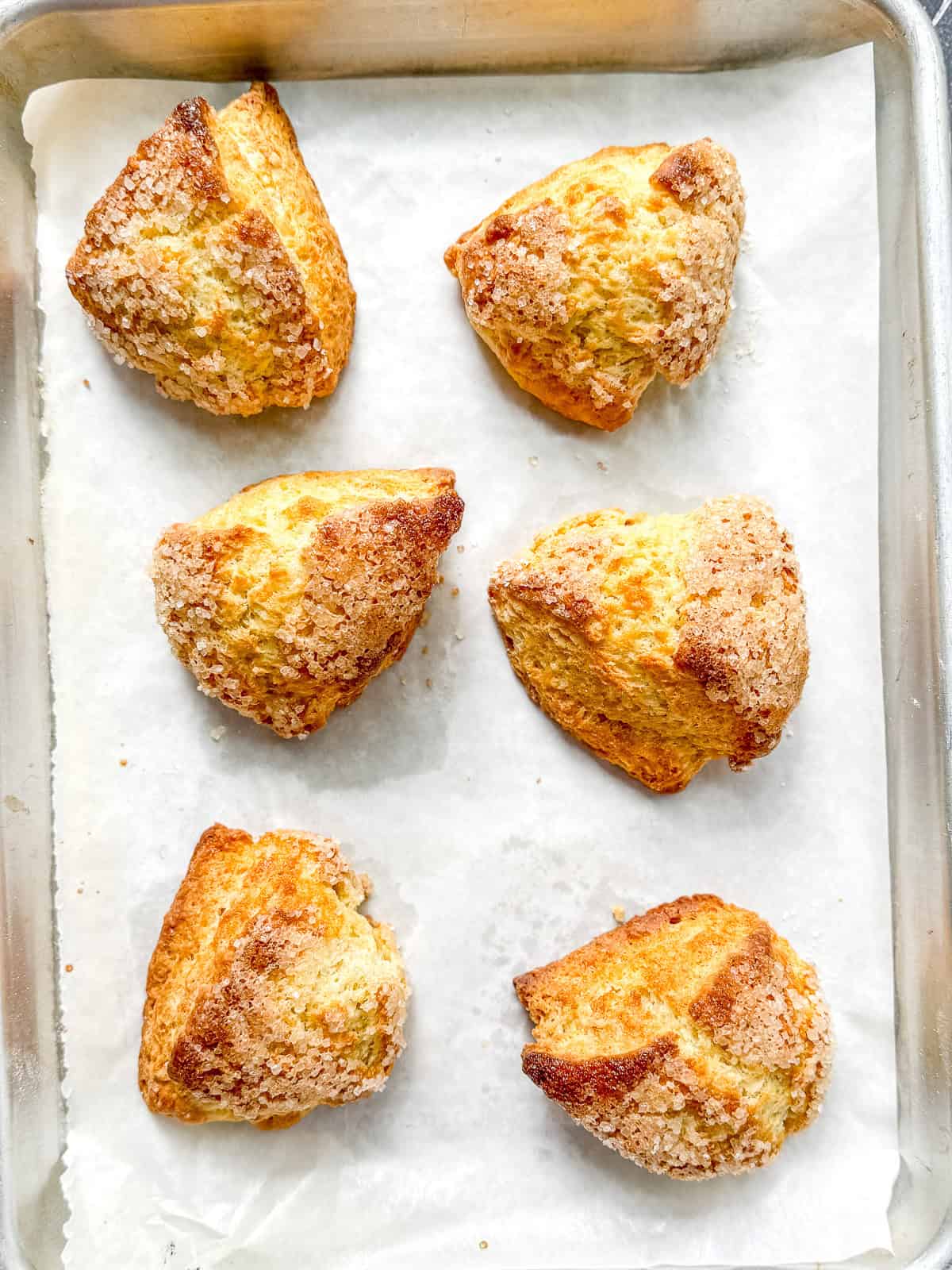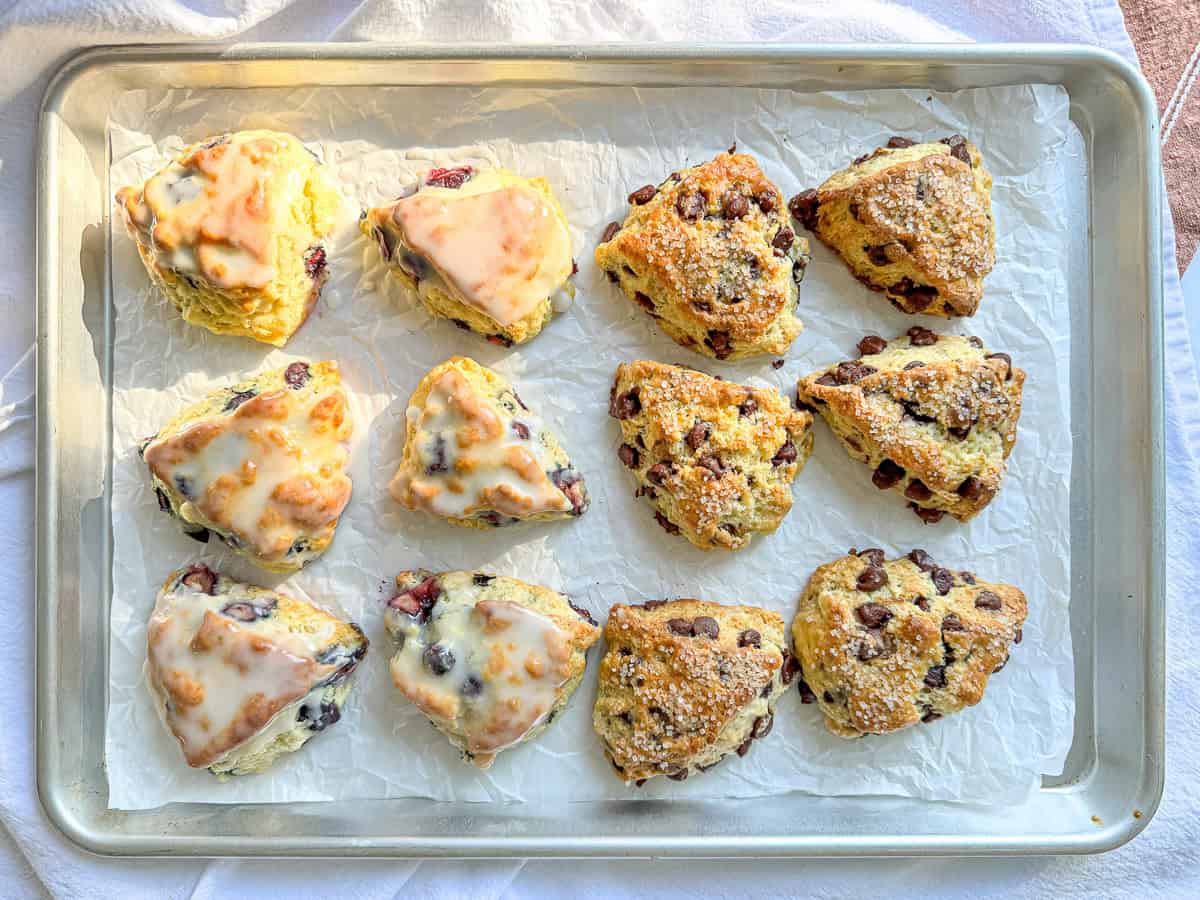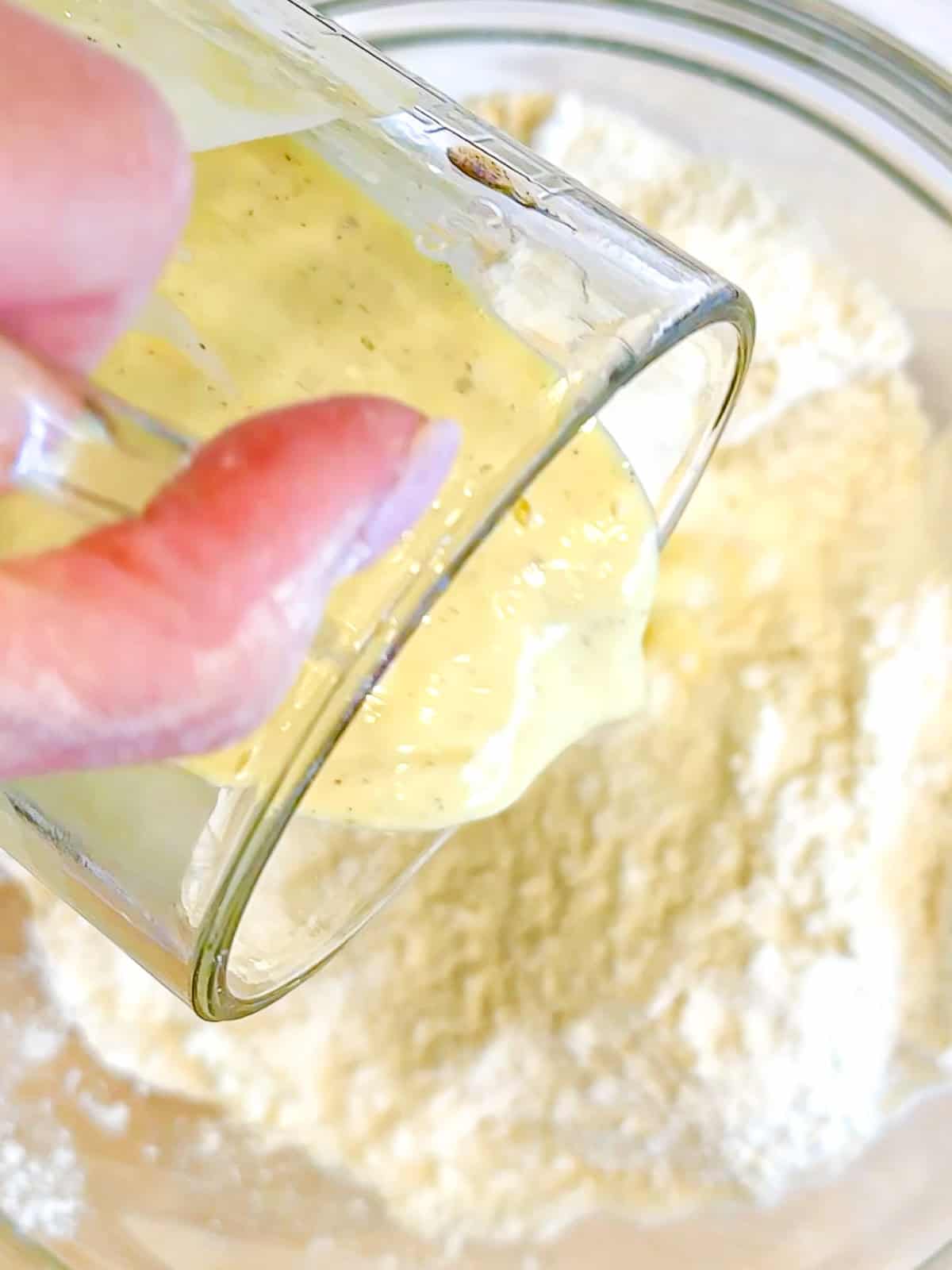These Classic Buttermilk Scones are delightfully tender and fluffy, incredibly easy to make, and the recipe includes fun variations-both sweet and savory-to suit any craving or occasion.

Save This Recipe! 💌
My Buttermilk Scones journey was a long and sleepy one. Before I was the Biscuit Queen, I was the scones scullion. In both of the bakeries where I got my start I was in charge of waking up super early (like 1 a.m. early), firing up the ovens, and making dozens, up to hundreds, of scones before the doors opened each morning.
Each bakery had its own scone recipe, and I've combined my favorite parts of them while tweaking them to fit my style. My fluffy buttermilk scones are simple to make, just lightly sweet, and bake up perfectly tender and moist.
This easy American-style scone recipe works with any sweet or savory add-ins without having to change the base recipe. I've worked long and hard to create my perfect scone recipe, and I'm ready for Afternoon Tea! Join me?
Jump to:
Ingredients & Substitutions
Many of the ingredients are similar to those that I use to make my buttermilk biscuits, but with minor changes to make them less flaky and more rich, fluffy, and tender. Let's take a look at the major players and see if there any substitutions you can make if you need to:

- All-purpose flour - All-purpose flour makes perfectly tender scones that can hold up to any add-ins you might include. If you have leftover self rising flour from making my two ingredient biscuits or my simple flatbread, you can use that and just leave out the baking powder and the salt from the recipe.
- Sugar - I include just 3 tablespoons of regular sugar in this recipe, making it just ever so lightly sweet, but not sweet. The sugar isn't there just for sweetness, it also helps to tenderize the scone and helps with the browning process. The amount balances nicely with any savory ingredients that you might add, but if you want to decrease it to one tablespoon, it will not change the recipe significantly.
- Buttermilk - Buttermilk is one of those ingredients that you don't think you need, but if you don't use it, you notice. Buttermilk scones are the best scones in my opinion. I love a delicious cream scone, it is really decadent, but buttermilk makes scones that are more tender, more fluffy, more moist, and just more delicious. If you don't have buttermilk, feel free to substitute with kefir, regular yogurt, or Greek yogurt that has been thinned with a little bit of milk or cream.
- Cold Butter - I always use unsalted butter in my recipes because there is no standard amount of salt between brands. If you use salted butter, cut the additional salt amount in half. This recipe for buttermilk scones uses less butter than all of my biscuit recipes, but don't worry that it won't be rich enough. We're adding an egg. (If you prefer, you can use a vegan butter in this recipe.)
- Egg - Some scone recipes, particularly traditional British cream scones, don't include an egg. The thinking is that not including it makes them more light and fluffy. If I want a pastry that's super light and fluffy, I'm going to make something with puff pastry. I came here for rich, delicious scones. But, if you can't find eggs or you just don't want to use them in this recipe, leave out the egg andincrease your buttermilk to ¾ cup (180 grams).
See recipe card below for a full list of ingredients and measurements.
Variations
I know when most people think of American style scones, they only think of them as being sweet, but you don't have to stop there. Scones are delicious both sweet and savory. Here are a few ideas to get you started:

Sweet scones
- Lilac - On a recent live cooking segment on New York Living, I made lilac sugar scones as part of a Brunch in Bloom theme. All I did was add one cup of lilac blossoms, individually plucked from their green stems, to 2 cups of granulated sugar in a large mason jar and set in on my kitchen counter. I gave it a shake every time I passed by the counter. After 4 days I spread the sugar out on a sheet pan, flowers and all, to dry. I then used the sugar, including the dried blossoms, to make delicious floral scented scones.
- Lemon blueberry - A classic is a classic for a reason. Start by adding lemon zest directly into your sugar and rubbing it in to release the oils. Add one cup of blueberries to your dough. Brush with a simple glaze made of powdered sugar, lemon juice, and a splash of milk.
- Cranberry - Add frozen cranberries and some orange zest for a seasonal cranberry orange scone any day of the year!
- Chocolate chip - Add a cup (or more) of your favorite chocolate chips to the dough. My husband prefers milk chocolate chip, and I can't say he's wrong!
- Fruit - Don't stop at blueberry, you can add any fruit to the scones. I love to add fresh strawberries, cut up and blotted dry on paper towel, and about a tablespoon of finely chopped fresh rosemary to make the most flavorful strawberry scones of your life!
Savory scones
- Sun-Dried Tomato and Basil - Add chopped sun-dried tomatoes and fresh basil for a Mediterranean-inspired flavor. Delicious with soup!
- Caramelized Onion and Gruyere - Toss sweet caramelized onions and shredded Gruyere into your dry ingredients for a sophisticated, savory bite. Amazing with steak or fish!
- Bacon Cheddar - Mix crispy bacon crumbles and cheddar cheese into the dough for a hearty breakfast. Serve with soft scrambled eggs!
Keep it classic Interested in a more classic twist? Try my Traditional British Scones, made with heavy cream. They're tender and light as air!
Instructions
Making this basic buttermilk scones recipe is a lot easier than you might think. I'm going show you how to cut them into the traditional American scone wedges, but you can also roll your dough out and cut them out using a biscuit cutter.
You could also add another splash of buttermilk to the dough and scoop them out like drop biscuits. They're your scones. Do what you want.

Step 1: Mix dry ingredients in a large bowl. Add in your cold, cubed unsalted butter. Work it into the flour with a pastry cutter or with your fingers using a finger snapping motion.
The mixture should resemble coarse crumbs with the butter in small pieces no larger than the size of peas. Stir in any nuts, chips, fruit, or other add-ins into dry ingredients now, before adding your buttermilk.

Step 2: Whisk together the buttermilk, egg, and vanilla extract, if using. Pour the wet ingredients into the butter and flour mixture and begin mixing. Save about a tablespoon of the liquid to brush the tops of your scones.

Step 3: Mix together until you have a cohesive shaggy dough with just a little bit of dry ingredients on the bottom. If you have a lot of dry left, add another tablespoon of buttermilk and keep mixing.

Step 4: Dump the dough onto a lightly floured work surface and use your hands and/or a bench scraper to bring the dough together into a large square.

Step 5: Use your hands, or the bench scraper, to fold the dough over onto itself two or three times, gently flattening it out between folds.

Step 6: Shape the scone dough into a disk about 6 to 8 inches across and use a sharp knife to cut into eight wedges. Place the wedges on a parchment paper lined large sheet pan and place into the freezer to chill while you preheat your oven to 400°F.

Step 7: Brush your chilled scone wedges with the leftover buttermilk and egg mixture from the bottom of the measuring cup or with an egg wash consisting of an egg whisked with 1 tablespoon of water.

Step 8: If desired, sprinkle the tops of the scones with a little bit of sparkling sugar. Bake in your hot oven for 18 to 22 minutes, or until golden brown.

Allow the scones to cool for 15 minutes before glazing or eating. I like to open mine up and spread with butter, blueberry jam, or apple butter.
Hint: If you want to add a glaze to your scones, here is a simple formula:
In a small bowl whisk together 1 cup (120 grams) of powdered sugar with 1 tablespoon of citrus juice and 1 tablespoon of milk. If you don't want a citrus flavor, use 2 tablespoons of milk and about ½ teaspoon of an extract, like vanilla or almond.
Expert tips
- Using a food processor - If you have hand mobility issues, or just don't want to mess with cutting in the butter, you can pulse the dry ingredients and the butter together in your food processor for about four or five pulses.
- Flakier scones - If you want taller and flakier scones, try using the cut and stack laminating technique that I use in my buttermilk biscuits.
- Fresh fruit - If adding any juicy cut fruits like strawberries or peaches I recommend blotting them dry on paper towels before adding so that they don't release too much liquid into the scone. I like to take the additional step of freezing the fruit, even my blueberries and raspberries, before adding them to the scones so that they don't break apart and smear into the dough.
- Crispy or soft edge?: Place scones slightly touching on the baking sheet for softer sides or spaced apart for crispier edges.
- Don't forget the finish: Brushing with leftover buttermilk mixture, cream, or an egg wash, before baking helps with browning and adds to the texture of the crust.
- Sugar top or not? - The general rule is, if you are going to glaze the scones, don't add a sugar topping. If you do, the glaze will be unattractively lumpy with the shapes of the sugar crystals. If you are skipping the glaze, be generous with your sparkles ✨✨.
- Serve fresh - Scones are best enjoyed warm, right out of the oven. If you need to bake them ahead, reheat them gently in the oven to restore their freshness.

Recipe FAQs
I wouldn't. Thinner liquids, like milk, will change the flavor and appearance of your scones. You can use another thick liquid like heavy cream or kefir, or even plain yogurt in its place.
Absolutely! The process is not that much different than my freezer biscuits. Place the cut scones on a tray and freeze for 1 hour. Then transfer them to a freezer-safe ziploc bag and store for 2 to 3 months. Bake from frozen, adding a couple more minutes to the bake time.
Store leftover scones in an airtight container at room temperature for up to 2 days, or freeze them for longer storage. Reheat unglazed scones in a 350°F oven for about 5 to 10 minutes for a freshly baked texture. If your scones are glazed, just give them a zap in the microwave for about 10 to 15 seconds. The glaze will melt, but they will be warm.

Did you try this recipe?
Please consider leaving a comment with a ⭐️ rating below and tell me all about it! It helps me to continue to improve my content and lets others know what you think!
I appreciate it so much!
-Cynthia
📖 Recipe

Classic Buttermilk Scones (with Variations)
Ingredients
Scones
- 2 cups (240 g) all-purpose flour
- 3 tablespoons (36 g) granulated sugar
- 1 tablespoon (12 g) baking powder
- ½ teaspoon baking soda
- ½ teaspoon fine grain kosher salt
- 6 tablespoon (84 g) unsalted butter cold and cut into cubes
- 1 (50 g) large egg
- ½ cup (125 g) buttermilk plus extra for brushing on top
- 1 teaspoon vanilla optional
- Coarse sugar optional to sprinkle on top
Glaze (optional)
- 1 cup (120 g) powdered sugar
- 2 tablespoons (30 g) milk or 1 tablespoon citrus juice and 1 tablespoon milk
- Tiny pinch of salt
Instructions
- Mix dry ingredients in a large bowl. Add in your cold, cubed butter. Work it into the flour with your fingers using a finger snapping motion. The mixture should resemble coarse crumbs with butter pieces no larger than the size of peas.
- Stir in nuts, chips, herbs, fruit, or other add-ins into dry ingredients now, before adding your buttermilk.
- Whisk together the buttermilk, egg, and vanilla extract, if using. Pour into the flour and butter mixture and begin mixing. Save about a tablespoon of the liquid to brush the tops of your scones.
- Mix together until you have a cohesive shaggy dough with just a little bit of dry ingredients left on the bottom. If you have a lot of dry left, add another tablespoon of buttermilk and keep mixing.
- Dump the dough onto a lightly floured surface and use your hands and/or a bench scraper to bring the dough together into a large square.
- Use your hands, or the bench scraper, to fold the dough over onto itself two or three times. Gently using your hands to flatten it out between folds.
- Shape into a disk about 6 to 8 inches across and use a knife to cut into eight wedges.
- Place the wedges on a parchment paper lined large sheet pan and place into the freezer or refrigerator to chill while you preheat your oven to 400°F.
- Brush your chilled scone wedges with the leftover buttermilk and egg mixture from the bottom of the measuring cup, or with an egg wash consisting of an egg whisk with 1 tablespoon of water.
- If desired, sprinkle the tops of your scones with a little bit of sparkling sugar. Bake at 400° for 18 to 22 minutes, or until golden brown.
- Allow the scones to cool for 15 minutes before glazing or eating.













Irene says
This is my go-to scone recipe. It's such a versatile recipe and I've made mostly a mini chocolate chip version or blueberry with glaze. It's a hit every time and has made beautiful gifts to family and friends. I've frozen a batch and it's baked up beautifully straight from the freezer and it was so convenient to have them on hand for last minute company.
Cynthia Christensen says
Thank you so much! I'm glad you make them as often as we do!
Ro Pagano says
Super easy and tasty! The dough is wet enough that it makes it easy to piece everything together. I love the savory scones. Made a ton and then froze them so I have leftovers to reheat for work day breakfast!
Julie says
This recipe is just what I was looking for - quick, easy, customizable, and delicious! Made a double batch for our weekly school breakfast. One lemon poppyseed with a lemon glaze and the other one with mini chocolate chips. Both versions were perfect!
Catherine Hiller says
Easy and delicious, these warm scones always amaze.my brunch guests. I tried using dried fruit (blueberry or chopped apricots) to give a little burst of color and flavor.
What a success! .
Cynthia Christensen says
Sounds amazing!!
Jacqueline Barrett says
Great recipe! Especially since I didn't have cream on hand. The buttermilk worked great. That's why I love your recipes! They are exponentially adaptable. I added a little cinnamon to the dough and liberally sprinkled cinnamon sugar on top while still warm from the oven. That way it stays crunchy.
You are terrific! I love seeing you on PIX11. You make it seem so easy and quick. And your recipes are! And they come out great!
Cynthia Christensen says
I'm so glad you loved them!